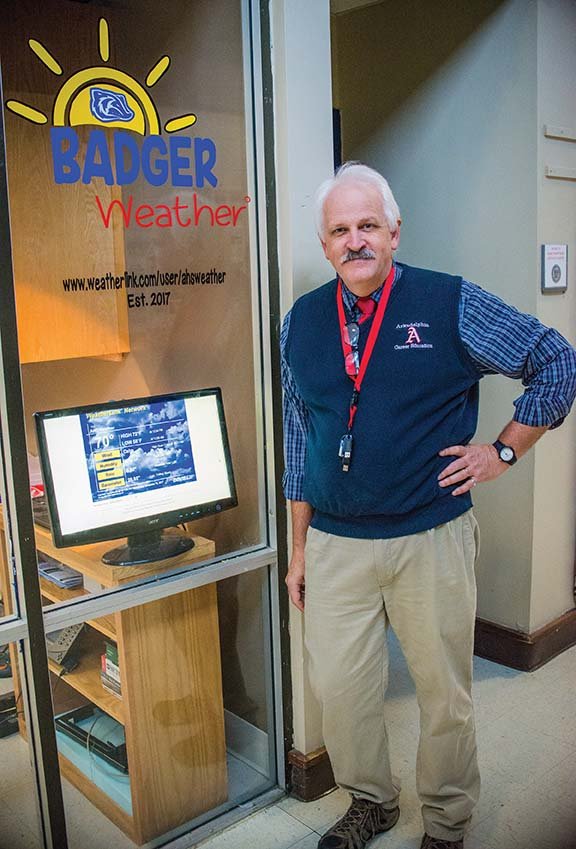ARKADELPHIA – Junior Sam Coventry walks by the Badger Weather Station monitor every day on his way to band practice.
“I walk by in the morning and see how hot or cold it is going to be when I am out there marching,” Coventry said. “It has already been helpful to me.”
Coventry worked alongside five other Arkadelphia High School students in building the first ever Badger Weather Station.
“We have wanted a weather station for years,” pre-engineering teacher Bud McMillion said. “We found that the temperature measurements that we get with this thing differ from what the phone apps are and are more specific.
“We actually get a little bit closer than what the phones do.”
McMillion said the weather station has been online for a little over three weeks. He said it took around three weeks to get the station up and running and installed on the roof of the high school.
“This was kind of a first-time experience for me, but it was pretty cool,” Coventry said. “Working together with people on a project like this is cool.”
McMillion said students, parents and community members have to get ready for many events at the high school. Anyone can view the current weather conditions by visiting the website at www.weatherlink.com/user/AHSweather.
“Knowing the weather conditions at the high school is, hopefully, a helpful bit of information that helps them plan how to dress,” McMillion said.
Senior Ethan LaFont said the project helped his class learn how to follow instructions and put things together in the right order. He said every student had a specific job.
“I did the programming, and I set up the website,” LaFont said. “I made sure the signals that we needed were working properly.
“They took it outside, and I was getting the readings, and they helped make it more stable.”
McMillion said the course is a junior- and senior-level course with the purpose of designing solutions to problems. The students have to identify a problem, then invent or come up with a solution.
“When I first started doing this, one of the things that kids needed to be brought up to speed on was how quality products are put together,” McMillion said. “They would come up with ideas that were really outlandish.
“They couldn’t pull them off because they didn’t really understand the intricacies of a product.”
McMillion said his classes have tried elaborate projects before, but this was probably one of the first successful ones.
“We expect to use it for years,” he said. “I did try to invest in a good piece of equipment that should last.”
Junior Owen Phillips, the public relations manager for the project, said one of the biggest hurdles was finding the ideal spot to place the weather station. He said the students considered a couple of spots, including on top of the field house, the press box at the football field or placing the weather station on a telephone pole.
“That was the main unknown when we started the project,” Phillips said. “We eventually decided that the roof [of the school] was the safest position for [the station]. There was no danger of it being attacked by accidents, falling limbs or students throwing rocks at it.
“And it provides accurate readings on the roof, and it is much easier to get to.”
Phillips said the students aren’t allowed on the roof, but the maintenance team can go up there and take [the weather station] down if [the students] need to work on it.
“So it will be much easier than mounting it on the press box or a telephone pole somewhere,” Phillips said.
McMillion said that originally, the students were going to have the Southwest Electric Coop put in a telephone pole.
“They actually agreed to do all that,” he said, “but we got to thinking that it would be more dangerous. If something were to happen to [the weather station], it is a lot easier to get to the roof than if it was on a pole.”
Senior Blanton Matthews downplayed his role on the project during his interview time, saying he was responsible for various odd jobs and not anything specific. But McMillion said Matthews served a more vital role in the project.
“Every morning, his job is to come by on the way to band and make sure the thing hasn’t shut down,” McMillion said. “Occasionally, he has to log in and change the settings. It is an ongoing learning experience for [the students].”
McMillion said the hardest thing to teach a student, at this level, is commitment to a project.
“In order for the weather station to work, they have to constantly monitor it,” McMillion said. “If it goes down, I don’t know anything about it. They are going to have to be the ones to fix it.
“So to me, that’s a real work skill.”
McMillion said the class will have to come up with a set of directions for the next group and have a training session with them to ensure the station’s longevity, “so I will have kids who will monitor things over the years,” McMillion said. “A lot of these kids are on our robotics team, which is a ninth- to 12th-grade group. That will be a good venue.
“I am committed to having [the weather station] for many years into the future.”
The next project for the class is to build a T-shirt cannon, and McMillion said the students are about two-thirds of the way finished with the cannon.
“It is for the cheerleaders to shoot T-shirts into the crowd during football games,” he said. “[This weather station] is meant more as a training activity, to help them understand what a good product looks like.”
Staff writer Sam Pierce can be reached at (501) 244-4314 or spierce@arkansasonline.com.
